Preparing for Sales Events
This week’s post is about something that I have been doing lately: preparing for sales events!
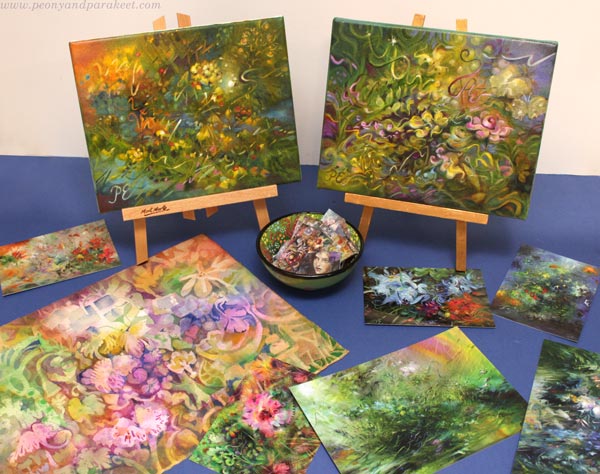
I participate in four events:
- A curated group show organized by the big gallery Gumbostrand Konst & Form
- A winter-themed group show organized by the local artist association where I am presenting Talviyön runoelma – Winter Night’s Poem
- 2-day Christmas sales event organized by the local artist association Vantaan taiteilijaseura
- Black Friday course sales event organized by me on this website!
For me, this is a lot! Fortunately, I have had time to prepare. For example, I got the deadline for the suggestions for the curated group show on Sept 1st. I was then able to apply and have new work specifically painted for the gallery.
Of these four, I am most anxious about the 2-day Christmas sales event even if it’s the smallest one! I have a sales table there, and I haven’t been preparing one for ages. I enjoy selling face-to-face, so it’s also something that I look forward to. It’s also great to see all kinds of sales items on one table and make a nice selection.
Selecting Sales Items – Delivering the Experience of an Original
Even the smallest sales table is a chance to strengthen your artistic voice and communicate your art brand. Most customers may buy postcards and other affordable items only, but still – we want to give them the whole experience. People have come back to me saying: “I remember you. I bought one card from you a couple of years ago, and I look at it every day.” I like to think that with the card, they also buy a piece of the world I am presenting to them. That’s why I always try to include original art as well.
Here’s one of the small paintings that I just finished. It’s called Samettikukan sointi – The Sound of the Marigold.
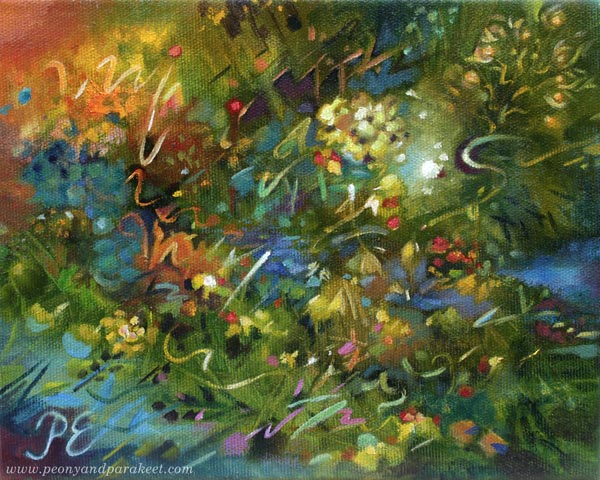
The Sound of the Marigold is a sister to a piece that I showed you earlier called Ruusun henki – The Spirit of the Rose. But when I placed the paintings side by side, I wanted to make adjustments to the rose painting so that its’ color scheme is less similar. So here’s the new version of The Spirit of the Rose:
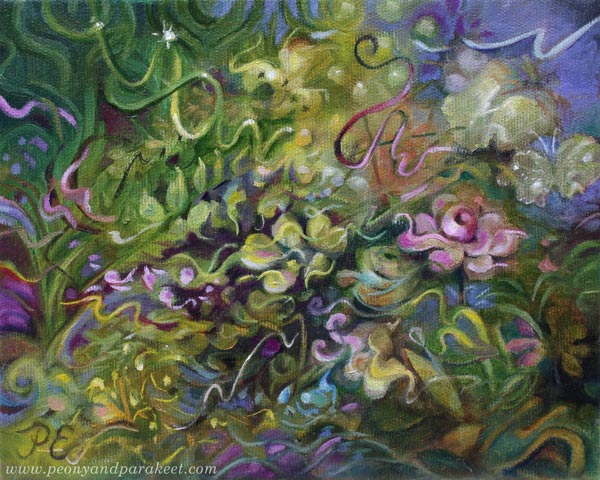
Here are the two versions together so that you can compare the changes.
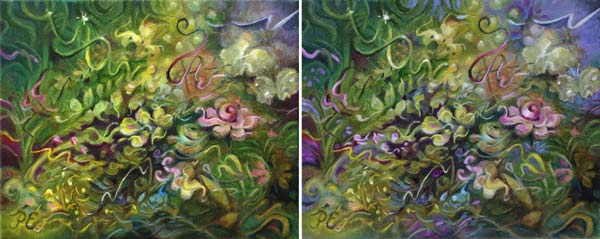
I am going to have small stands for them so that they will stand out from the rest of the selection.
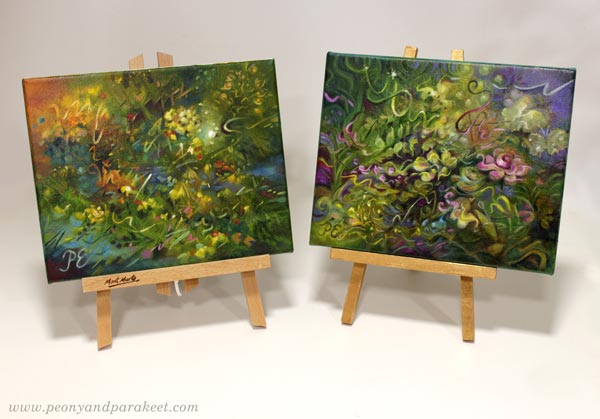
There are also a couple more small oil paintings. They are still in progress, but I hope to finish them soon so that they have time to dry.
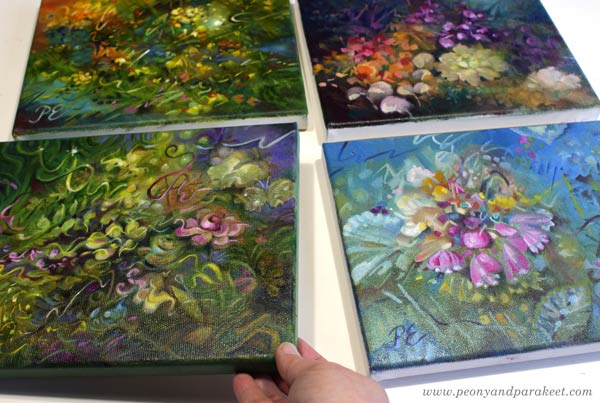
I have noticed that people who don’t regularly go to art events forget the difference between a photo and an actual painting. – like it would be the same browsing the feed or picking a postcard as watching an original.
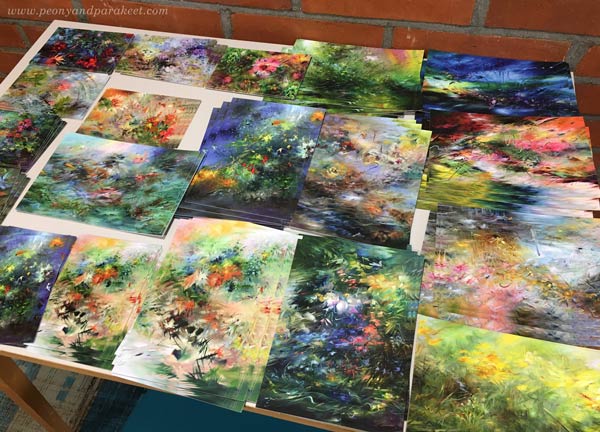
On my sales table, prints will dominate in quantity. And because most of them are pictures of oil paintings, I also want to deliver the experience of an original oil painting. With the four small ones, I can hopefully present one medium-sized original, maybe Forest of Wishes.
What A Part of Your Audience Expects to See
In my experience, some people are interested in a specific art technique. Previously, when I had the sales table at a similar event, there were some who wanted to talk about watercolor painting and were disappointed that I only had one example or so. These are people who are art hobbyists themselves and who are potential customers for my classes.
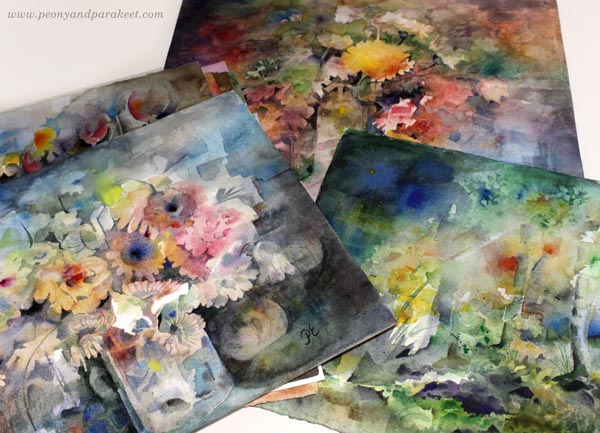
I used to paint a lot in watercolor, but lately, not so much because they don’t sell as well as oil paintings and have a low price point. Because I need to make a living and because I enjoy creating big paintings, I have focused on oils. But this time, I thought I would take a bunch of watercolor paintings with me and set the price lower than expected. If I still actively sold watercolor paintings, I wouldn’t do that, but now I see the chance to reach this part of the audience and show my watercolor work.
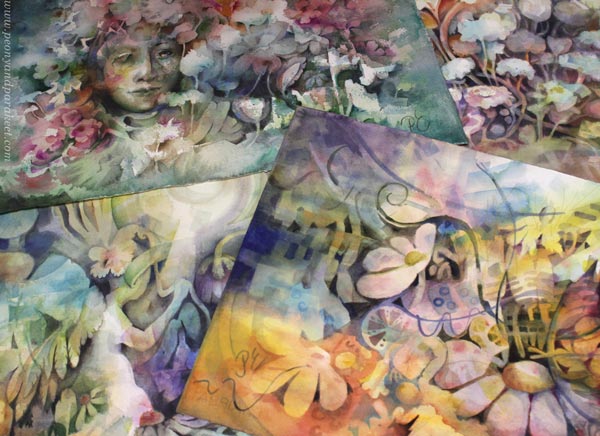
Because most elements of my style were developed in watercolor first, these pieces fit well with cards that have oil paintings.
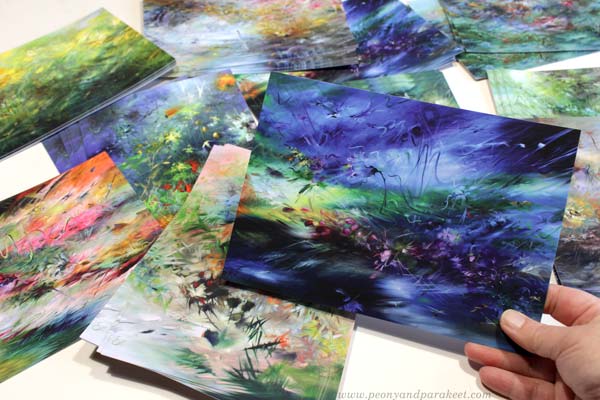
These cards came out gorgeous! They have a satin finish and are bigger and thicker than standard postcards. I ordered them as well as the cards from Moo.com (affiliate link, but I would recommend them without one too!)
What to Leave Out
Many times, I have put everything I have on the sales table, and that’s never been a good thing. You might have potential best sellers, but bringing items that don’t make sense to them will ruin the sales. For example, I brought fabrics with my designs and some craft items to an event focused on fine art. And vice versa, I took some original art to a craft show. Yes, you might get some sales from the odd items, but confuse most of the audience.
Price can be a reason to exclude some too. For example, if the organizer takes a percentage of the sales or if the price of the sales table is high, selling the most affordable items doesn’t necessarily make sense. And vice versa: when people come for good finds on their way to the shopping center, selling the biggest and most expensive pieces can be hard.
This painting – Tiger’s Eye – has been waiting to get to a curated exhibition that interests art collectors. Now I am happy to pack it and two other paintings for a big gallery show.
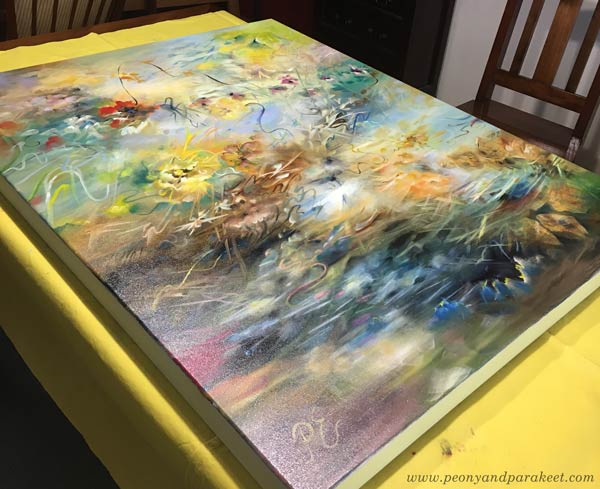
My oil paintings always get a varnish and a hanging wire so that they are ready for hanging on the wall.
In my experience, original art that is ready to hang is more tempting to buy than pieces that require, for example, framing. However, if the price point is very low, it doesn’t always make sense to frame the pieces. Whatever the case, it’s always good to present a unified collection and leave out some that are too different in size, style, or frame than others.
When selecting work for the small postcards, I left out many paintings I like and value. For example, many of my big paintings are not so great for postcards. Their details get lost in the tiny size, and their subject is more suitable for decorating interiors than sending wishes.
And then some paintings are quicker but more suitable; for example, Kukkiva maa – Flowering Earth that I painted in acrylics for the class Floral Freedom.
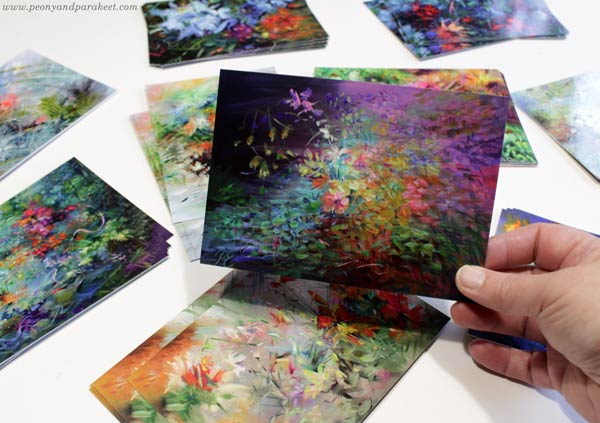
I think it’s perfect for a postcard – full of colors and flowers!
How You Will Be Remembered
Many times when I have been preparing for the events, my behavior has been on my mind: Am I able to show my enthusiasm? How could I not only make sales but be remembered afterward too?
But the best answer here is quite technical. You should have something to give that has your contact information on it. And all your products should have your name and website – or at least an email – on them. I use the same tactics, the same generosity that is, that I have used with selling online courses. I give something for free and invite people to see if I am suitable for them. On the sales events, I have small cards that have different pictures – details of my art – and I invite people to pick one that they like.
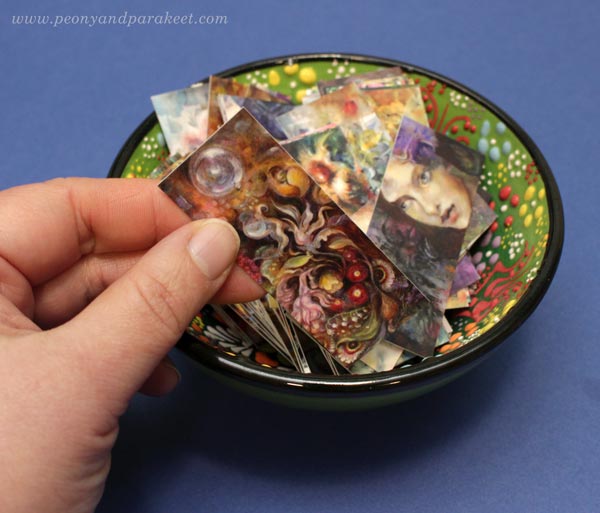
This begins a conversation about their likings about them, and when they have the mini card, I can serve them better and be remembered too.
The postcards also have contact information printed on the back.
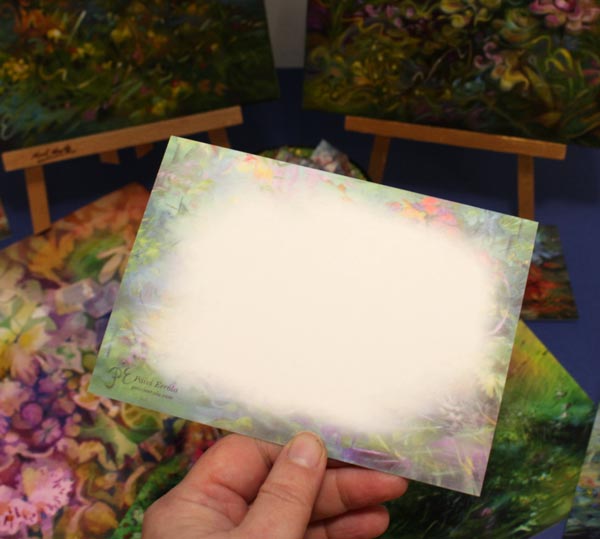
There’s also another artwork as a frame.
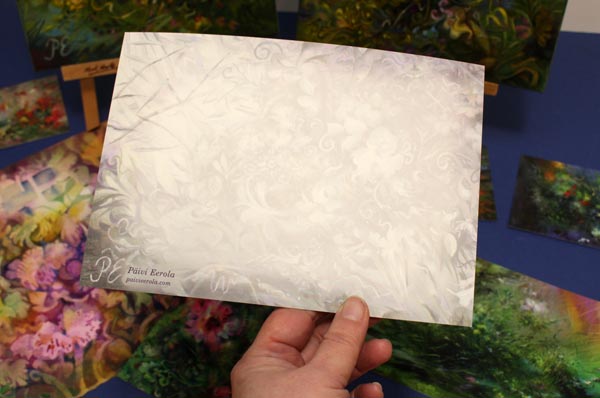
I think about these features as generosity as well. I have taken the time to design the back to make the cards even more valuable.
Sales Events Are the Opportunity to Test
Even if it’s good to have a unified style and selection, the sales event is also an opportunity to test new ideas and approaches. I like to do tests that are not big new things but hidden in the small stuff. This time, I made a postcard of my colored pencil work to see how many people can recognize the medium and how many are interested in this style of drawing.
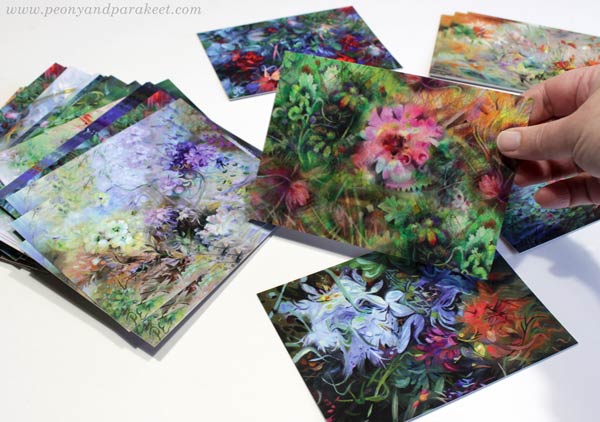
This postcard is composed digitally of many colored pencil pieces.

As you know, I am not just an oil painter, but also love colored pencils. It would be fun to talk about them too.
This leads us to my course sales event on Black Friday weekend. All classes will be on sale and registration for the new class Doll World will open. Doll World will begin at the beginning of January.
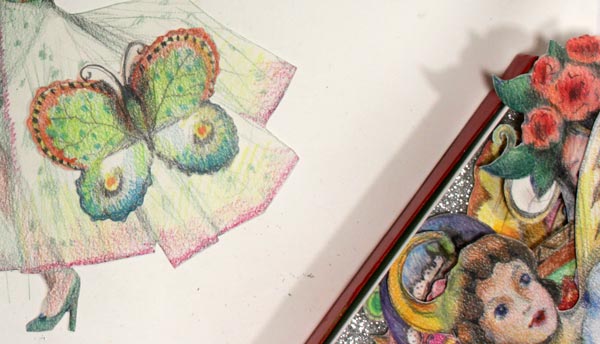
During the years, I have learned that if I love the class, there’s a possibility that you will love it too. The same goes for all art really. We have to pamper it and give attention to its needs. And when the course or the painting asks: “Will there be anyone for me?” we must say: “Yes, my dear – kyllä kultaseni – sometimes it will just take a little bit of time.” We both feel vulnerable about this.
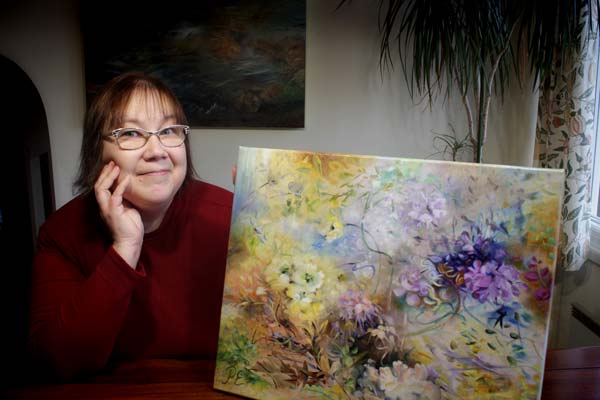
P.S. The engineer in me says that this is not a comprehensive article about setting a sales table. But I intend to share some pics when I set the actual table on December 3-4 at Galleria K, Vantaa, Finland. So stay tuned for Black Friday sales and future blog posts!
Bringing Old-World Feel to Abstract Floral Painting
This week, let’s dive into the old-world feel and get inspired by the opera singer Edita Gruberová!
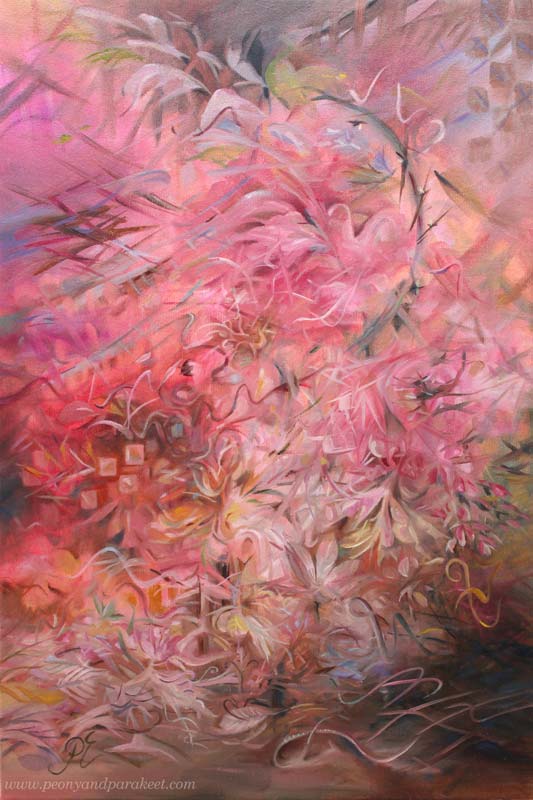
Ideas Behind the Painting
I listened to the opera singer Edita Gruberová (1946-2021) while working on this painting. Her version of the famous aria Queen of the Night from the opera Magic Flute is exquisite. Gruberová’s voice is partly like a bird’s not a human’s voice at all, and the aria brings that up well. The music editor Outi Paananen calls her a nightingale of Slovakia.
The transformation from a human to a bird felt inspiring. Maybe I could do a transformation of a painting so that my free and careless strokes would turn into decorative swirls, adding an old-world feel to an abstract floral painting. I had done something similar just recently but in a much smaller piece. See this blog post where I revamped a flower painting! From that experiment, I knew that it would take both time and patience. In a bigger piece, I could also get lost in the details so that the painting becomes confusing.
Before listening to Edita Gruberová, I already had a lot of ideas, collected in the blog post called Pink Inspiration. And now I wanted to add her and her birds to the painting too. I heard Edita’s story from Outi Paananen’s excellent radio program “Narrin aamulaulu” (in Finnish) on the Finnish Broadcasting Company. She had a clear artistic vision and strong willpower, and she demanded a lot of herself. It inspired me to challenge myself too.
Bringing Old-World Feel – 2 Tips!
In the past, painters often started with sketches and made detailed underpaintings with two or three colors. But a looser approach is not an enemy to the old-world feel.
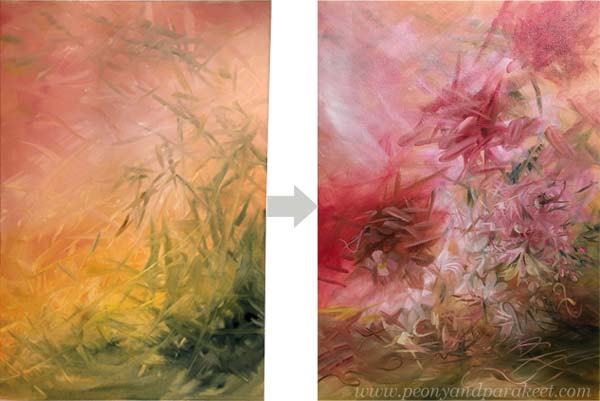
When you want to bring an old-world feel to an abstract painting, two things are the most important:
- Blurry on the bottom! Start from the background with soft transitions from light to dark, add blurry shapes, and paint like you would see the scenery from a far distance.
- Sharp on the top! Add sharp shapes and lines on the top of blurry ones. You can sharpen some blurry shapes but do it only partly, leaving some parts more undefined. But most importantly, let sharp lines and shapes sing the melody of their own. If the background is the orchestra, the top layer is the singer that has a melody of her own.
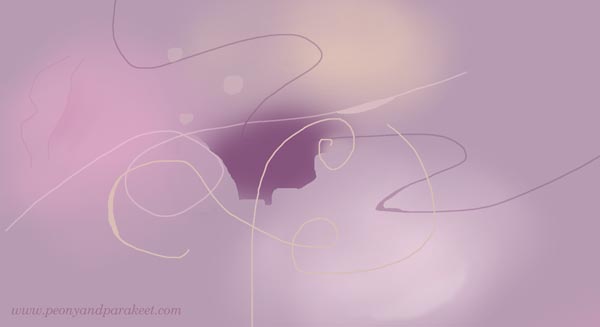
The thickness of the lines can change in places and there can be decorative dots too.
Timelessness Takes Time
It’s always tempting to get the piece finished quickly, but to get the sense of timelessness, the time has to stop while painting. So, I focused on tiny details and immersed myself in building a wondrous world with curves and swirls.
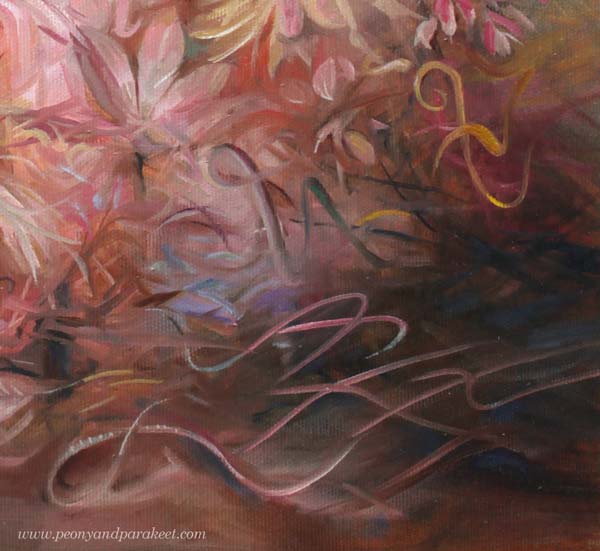
My lines are like old-fashioned handwriting in places. I have practiced them by drawing for a few years. Any note or waste paper can be used for practicing! I often doodled on planner pages.
Intuition and the Ability to (Not to!) See
As usual, I didn’t use any direct reference photos for the painting but worked intuitively. However, I tried to reduce the human ability to see ordinary concrete objects like flowers, faces, or such in simple forms. For a long time, I have thought that the ability to see is a part of creativity. But the more I create, the less I need the ability, at least in the first place. Seeing too soon makes me hurry and my art much less unique. So I try to let the shapes fly free and the big picture appear without too much forcing and seeing.

During the process, a little bird-like mesh appeared on the right. When I was making the final touches, and intentionally made him a partner in the center.

Sadly, Edita died last year, just before I discovered her, so I can’t send her a photo. But I want to honor her with this blog post and ask you to listen to her singing on Youtube. Isn’t that inspiring!
A Series in Progress
I have been painting like mad this month because I have to get everything finished for my solo show in June very soon. So, there are lots of paintings in progress in the studio!
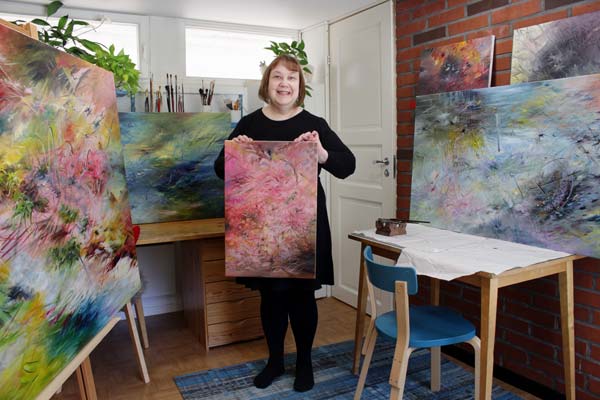
Easter was mostly spent with brushes, and if this wasn’t my ultimate passion, I would be quite exhausted already! Also, seeing the flow of wonderful creations from the students in my community Bloom and Fly energizes me a lot.
Let’s keep creating and inspiring each other!
How to Freely Express Sunshine
This week is about the sun! Let’s dive deeper into how to express sunshine when you want to create freely without reference photos. My example is an oil painting, but you can apply the tips to any supplies.

Here’s my newest painting that begins the new series where I explore the stars and planets of the Milky Way. The subject of the first one is, of course, the sun! I named the painting “Runaway Sun” – “Karannut aurinko” in Finnish because I wanted to express sunshine in a dynamic way.
Closed or Open?
Often we paint or draw the sun as a static yellow spot in the blue sky, but I feel that the sun is different. It’s not a closed circle but a very open one. It’s radiating and moving, making things appear and disappear.
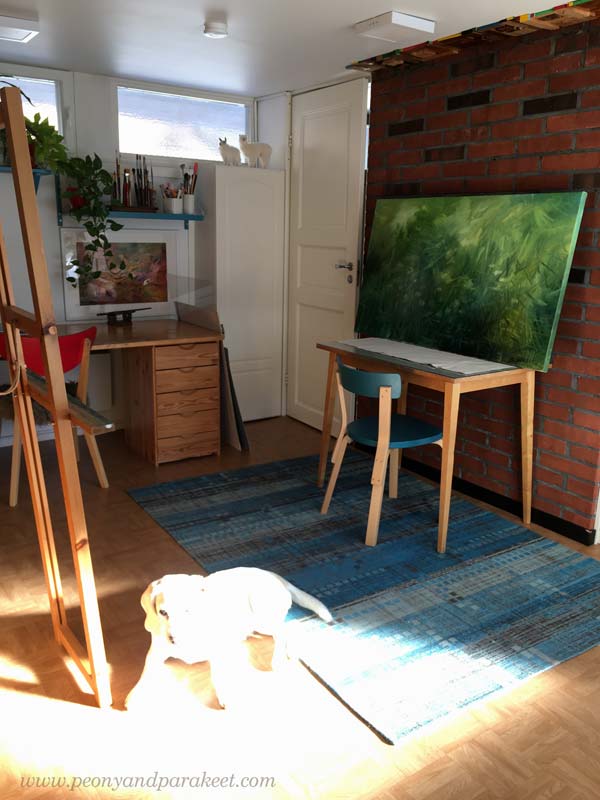
The painting was only a green mess when I took the picture above. “Oh no, the photo of Stella failed badly!” I thought when looking at it. But then, bad photos are the best. They challenge us to see what the world really looks like. Here, the sun has swallowed Stella and entered the room like a giant animal, so it’s not a little closed spot at all.
Isolated or Impactful?
The sun is the star, and the earth belongs to its solar system. The earth could be seen as a toy and the sun as the one who plays the game.

But in our art, the sun often has very little effect on its surroundings. We isolate the sun and keep it far away. For example like this:
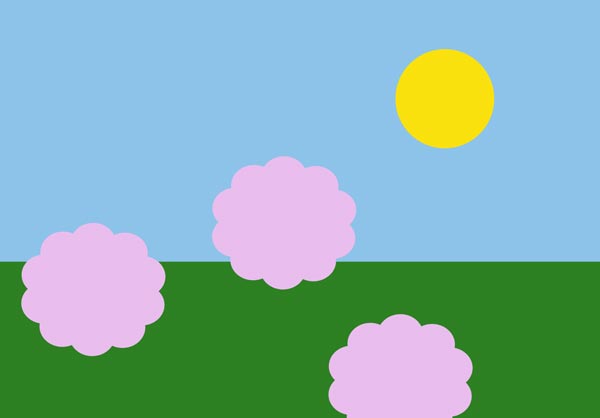
But the sun impacts everything. It travels in the scenery like a runaway that goes here and there, but it’s impossible to catch as a single being.
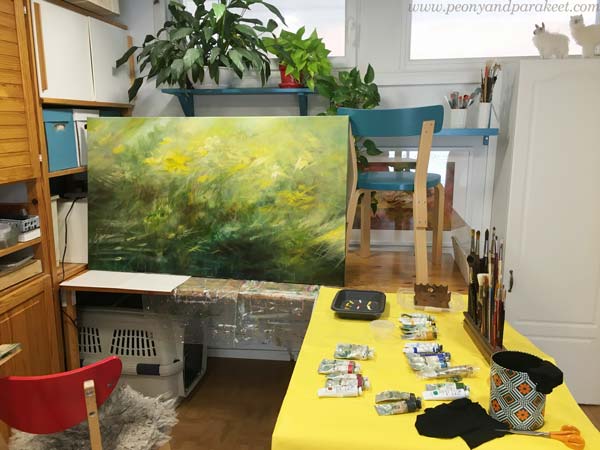
When my painting progressed, it got strong differences between light and darkness. The sunny look requires shadows too!
Is the Sun a Thing or a Person?
Art is only a technical skill as long as you think about drawing or painting things. But if you treat the elements as living beings of some kind, the game changes. When your paper or canvas is filled with people or animals, not just shapes or flowers, everything gets more exciting and it’s easier to express sunshine too.
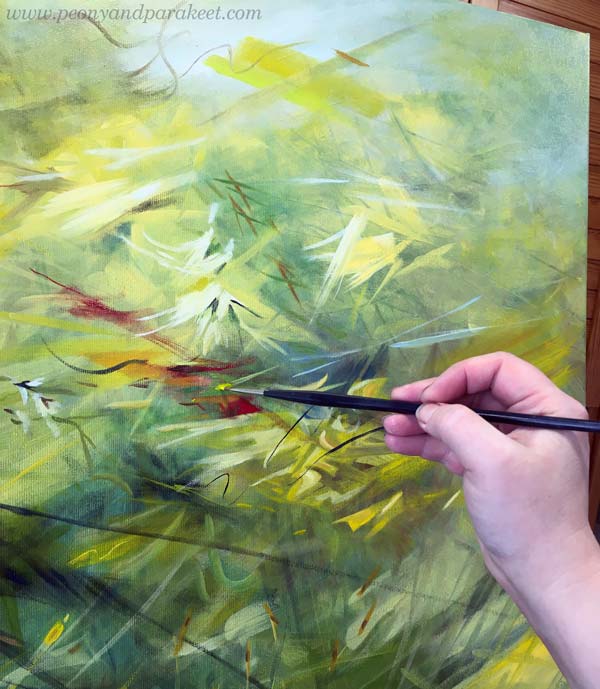
So, ask: Who is this person called Sun? How does she impact everybody in this piece?
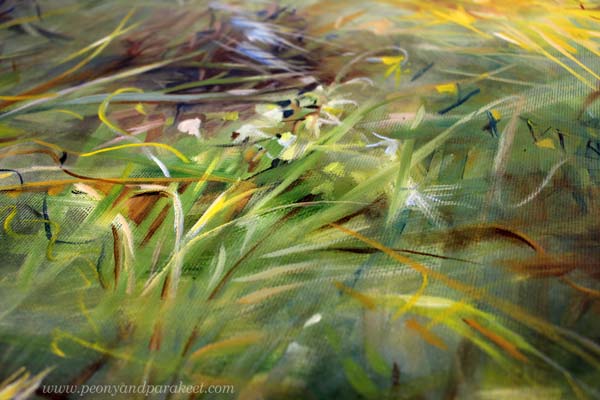
Some will love it, and some will escape from it.

Yellow or White Sunshine?
Some people get any yellow for the sun, and some select their yellow carefully. But I think that one yellow is never enough, and without white, the sun doesn’t shine.
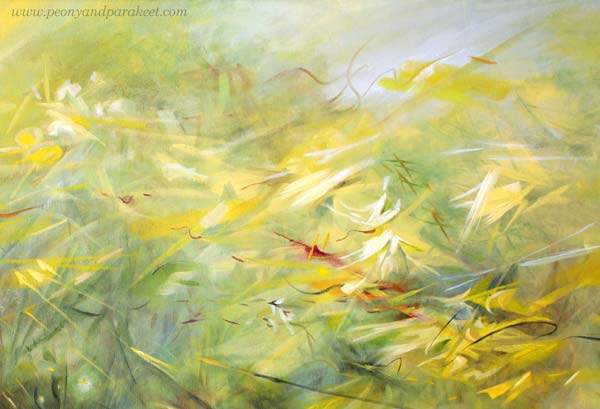
I usually work with a limited set of colors, but I change the tubes every session. So, if I use Indian Yellow in one session, for example, I switch to Lemon Yellow in the next. I do the same for other colors as well. When I create new color mixes from different base colors, my paintings will get a huge variety of tones and look more natural.
I try to always mix some color to most whites so that the variety of pastel tones is present too.
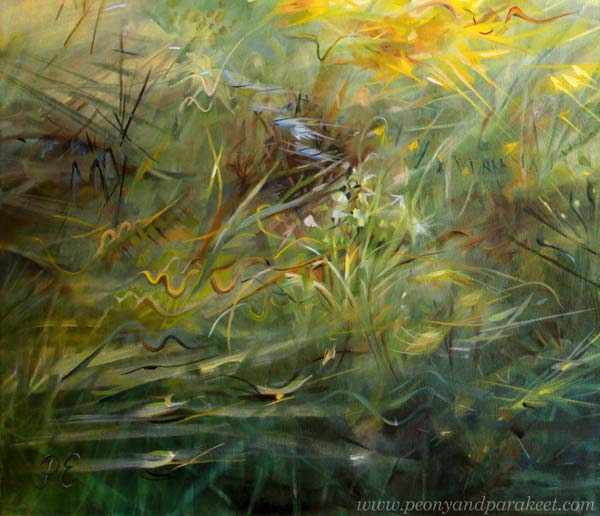
I also add color to blacks or make my own blacks. Browns and blues make wonderful darks!
Does It Express Sunshine? Test!
I like to do a test for all my paintings where I lay them on the table, walk away from the room, and then get back.
I wrote about the test in this blog post too.
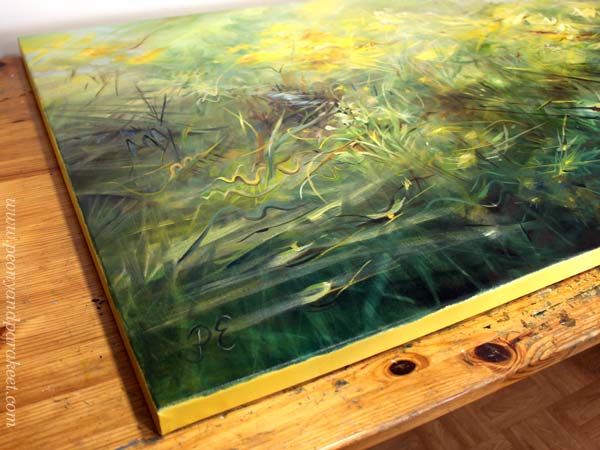
By resetting my mind, I try to get an immediate impact of how the painting affects the surroundings and whether it’s captivating enough. The sunny painting should draw attention and warm the room.
Here’s my little studio one night with other paintings that are still in progress.
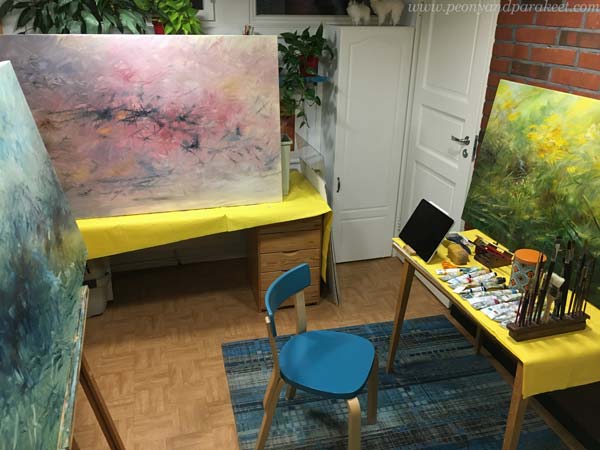
The paintings are too big for my little studio, but I have decided to manage!
Sunshine to Your Weekend!
I hope this post inspired you to bring more sunshine to your art!
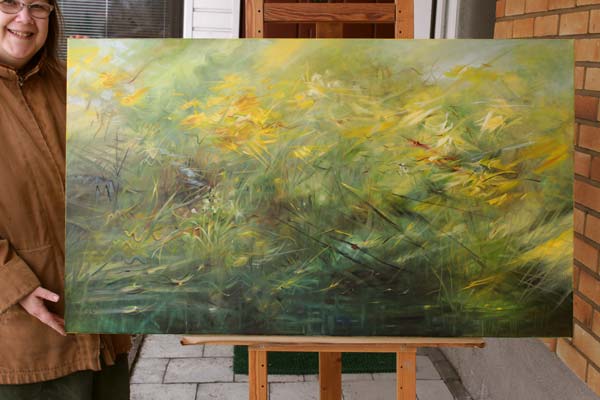
Happy Easter!
Using Leftover Paint – Messy Backgrounds and Beyond
This week, I show one of my art journals in the video and share ideas for what to create from messy backgrounds.
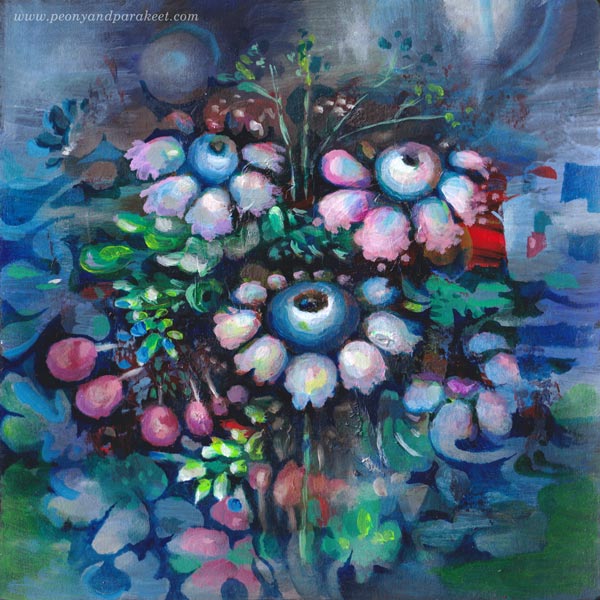
After a painting session, there’s usually some leftover paint on a palette. I try to squeeze the tubes carefully, and sometimes I put the paint in a box with a lid, but most often, I grab an art journal and wipe off the extra paint from the brushes and palette. If I am tired, I just spread the paint carelessly. If I still have energy, I add details to a page that already has some color. When I don’t like something in the next session, I paint new strokes over it.
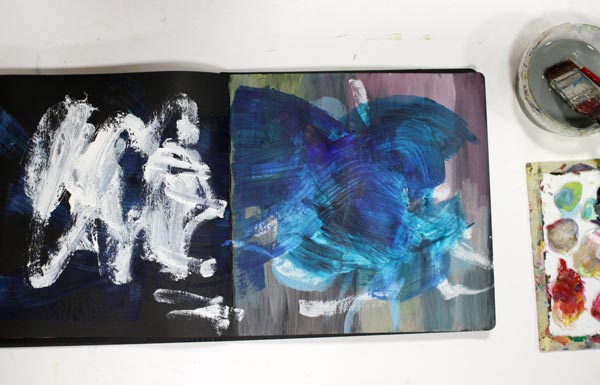
Many Rounds – Some Quicker than Others
I rarely make a page at one go. This spread has oil paints, and it took ages to finish it. But it didn’t matter, because I was practicing for the class Decodashery, and I needed time to dig into the heart of decorative painting style.
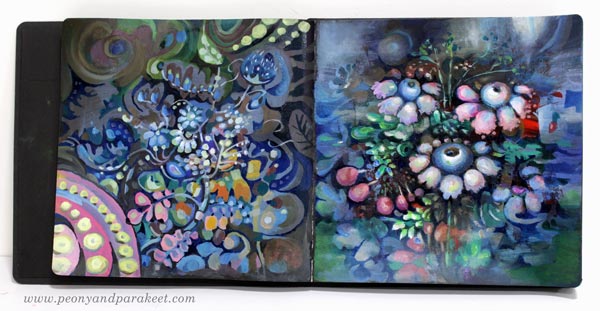
However, the one below is more abstract, and it was really quick!
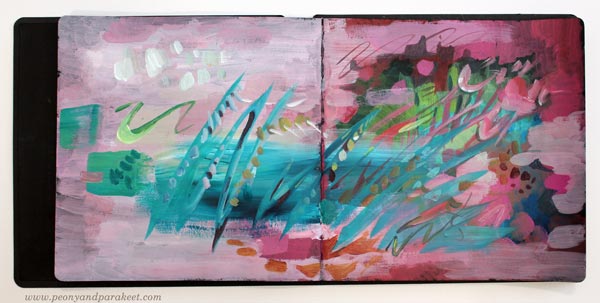
Messy Backgrounds and Beyond – Watch the Video!
In the video, I show messy pages and not so messy pages of my current art journal and how I finished the spread above. Watch the video!
Even if bigger paintings are my main work, art journal pages are an important part of my creative process. It’s like yin and yang! I need the mess-making to find joy in working with details.
Art Inspired by Music
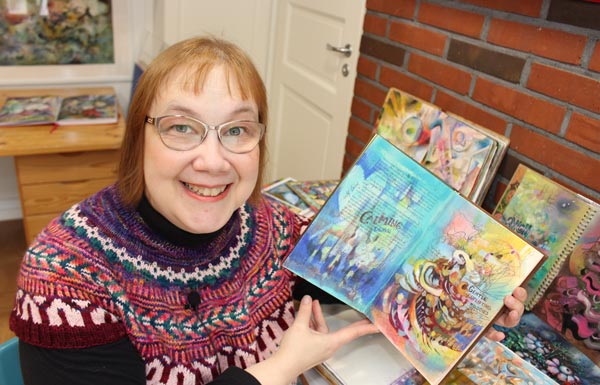
In the video, I mentioned the idea of visualizing a musical landscape and a melody. Music is the theme in my mini-course for Gratitude Junk Journal 2020 as well. This online workshop has 12 instructors, and it begins on Nov 1st, 2020. Register in October to get 20% off. Enter JOY2020 at checkout. >> Buy Here!